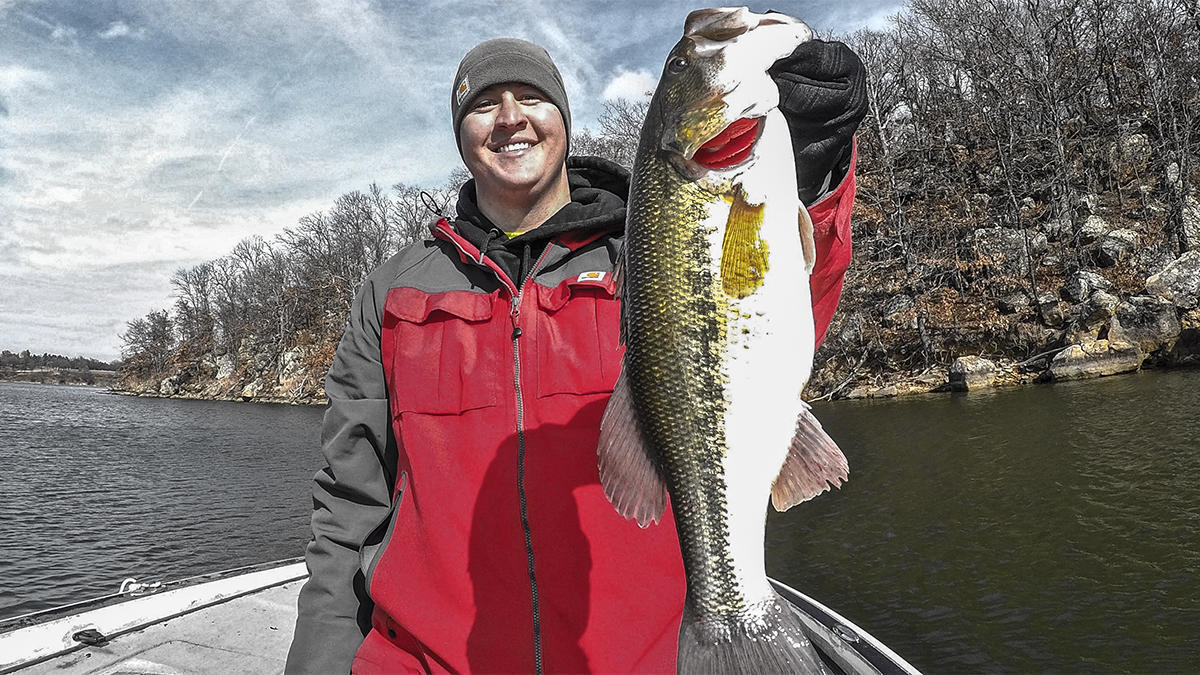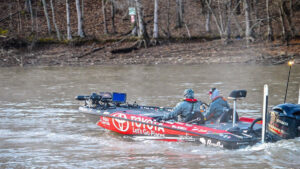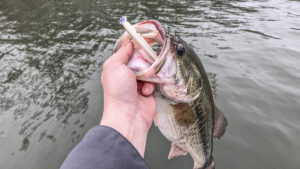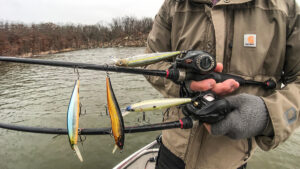Jerkbaits are some of the best lures to use when fishing for bass in the winter. To be fair, jerkbaits are excellent tools for bass anglers all year long; but when the water temperatures drop into the mid 40s and below, jerkbaits become one of the most productive options for targeting bass.
Anyone can catch bass with a jerkbait, but learning how to apply this particular technique to different bodies of water in diverse conditions takes time, patience and a fair amount of failure. How a jerkbait looks and behaves underwater has a lot of variation based upon lure choice, the tackle paired with the lure and perhaps most importantly, the action you impart upon the bait.
Cadence counts
A jerkbait slowly twitched through the water is a terrific imitation of an injured or dying shad, especially in cold-water scenarios when shad die-offs are common. Figuring out a jerkbait bite can be tricky, but in my opinion, it all starts with fine-tuning the cadence. Cadence is a musical term essentially referring to rhythm, but bass anglers use it to describe the movement we give lures on the retrieve. Think of cadence as the rhythm or beat we follow when twitching (dancing) a lure back to the boat. The tricky part – there is no such thing as the best, or “the right” cadence.
Sometimes the bass seem to want a jerkbait paused for painfully long periods of time between twitches. Then there are days when bass are best fooled by a jerkbait moved quickly, even in winter. Many anglers, myself included, have a bad habit of retrieving a jerkbait with the same or similar cadence throughout a day of fishing. It’s easy to get caught in a rut, even though “jerk-jerk-pause” isn’t cutting it.
Bass fishing superstar and cold-water specialist Mike Iaconelli preaches it is important to experiment with different cadences or retrieves when jerkbait fishing.
“I try to change my cadence every 15 to 20 casts with a jerkbait until I get a bite,” Iaconelli said. “Varying your retrieve is always important with a jerkbait, but especially when the water temperatures are in the mid 30s to the mid 50s. I alter the length of my pauses but I also change my rod tip movement and how hard I jerk the bait. These little changes dramatically affect the action of your lure underwater.”
Iaconelli’s performance at the 2013 Bassmaster Classic on Grand Lake provides a perfect case study on why experimenting with cadence is imperative. During the first day of practice for the event, Iaconelli recalls he never had a single bite on a jerkbait, even though the conditions set up perfectly for it.
Slightly frustrated, Iaconelli tried using smaller, softer twitches when moving his jerkbait on day 2 of practice. Almost immediately, he caught a bass. By being less aggressive with his cadence, Iaconelli was able to run around Grand Lake and uncover a jerkbait pattern that ultimately led to a 4th place finish. Meanwhile, on the same body of water in the same exact tournament, Kevin VanDam notched a top 10 finish by vigorously snapping his Strike King jerkbaits. Moral of the story, there is no magic jerkbait cadence for bass fishing.
“I don’t allow myself to have a go-to cadence because I want to fish the moment every time I’m on the water,” Iaconelli offered. “As a general rule of thumb, the colder the water temps, the longer I let the bait pause in between twitches and the softer I jerk the bait with my rod tip. In contrast, in warmer water I move the bait quicker and more forcefully. The cadence I use changes on every body of water I fish, even throughout the day based on the conditions!”
Alternate the cadence and movement of your lure until you get the first bite. Pay attention to how the bass was hooked and then do your best to replicate that action on the next cast.
Other ways to change action
While varying cadence is key, it’s not the only way to change the action of your jerkbait. Over the years bass anglers have figured out several ways to change the way a jerkbait behaves under water. First things first, don’t be afraid to try different colors, brands and diving depths of jerkbaits. All jerkbaits have slightly different actions and a small change can bring surprising results-especially in clear water.
“The first thing you can do is simply change the type of jerkbait you are using,” Iaconelli said. “The Original Rapala Shadow Rap and the Shadow Rap Shad are two jerkbaits that look similar to the naked eye but have very different actions. The Shadow Rap is designed to go nose-down and slowly sink on a pause, while the Shadow Rap Shad will go nose-up and slowly rise when paused. Subtle differences, sure, but they make a huge difference to a coldwater bass.”
Changing the line size and type you pair a jerkbait with also modifies how your lure reacts on a retrieve. Ask 10 jerkbait aficionados and you may get 10 different answers on which fishing line is the best to use.
Some anglers swear by fluorocarbon which sinks, has less stretch and helps the bait get down a little deeper; while others employ monofilament which floats and allows a little stretch which many argue gives cold-water bass a better chance of being hooked. All options can work, but understanding how the different lines and sizes affect the action of your lure will help you catch more bass with jerkbaits.
If you still aren’t getting the desired action out of a jerkbait you can use different sizes and styles of hooks, split rings, snap swivels or add suspend dots and wire wraps around your hooks to adjust the buoyancy and movement of your plug. There are as many tweaks and modifications for jerkbaits as any lure in a fisherman’s tackle box, but they all make important changes.
The key is to not be stubborn when fishing a jerkbait this winter. They are one of the best ways to catch bass in cold water and small adjustments make a big difference. Start with varying the cadence on your retrieve regularly and pay attention to the details to help you make further changes to your lure as necessary.
















